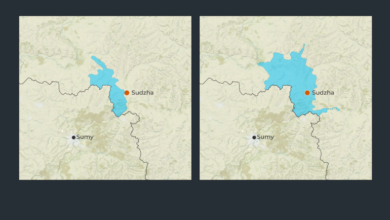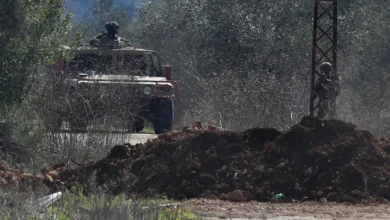The bitter final showdown over British coal, as sun sets on ‘dirtiest fuel’

“We were five miles (8km) out from here, 2,000 feet (609 metres) underground.”
David Cradduck, 77, used to be one of many men who would line up to begin their descent each morning through a vast network of mining shafts and subterranean tunnels that took them deep under the Irish Sea.
Hundreds like him flowed in and out of the Haig Pit deep mine until this colliery, like many other coaling sites in the area, shut in the mid-1980s. Now, pointing to the marine expanse before us, Cradduck proudly recounts the exploits of these men’s craft and labour.
“The coal in that shaft is about 600 feet (183 metres) deep,” he says. “We went through the coal and then dug tunnels out until we met the coal seams.
“Then we followed the coal seams – they dipped to the southwest. It’s amazing to think, really. Every day down there for 20 years of my life.”
The sprawling, rugged Cumbrian coastline is where Cradduck and thousands of others used to start work at all hours of the day and night. Built around coal and iron ore mining, in particular, the economy of the West Coast spiralled into progressive decline when its heavy industry began to be decommissioned and shut down in the second half of the 20th century.
But the coal seams here were still thought to be viable when the area’s pits suffered a series of sudden closures during this time.
Cumberland’s coalfield is vast. Larger in surface area than British territories such as Jersey or Guernsey, it is estimated to cover between 150 square km (58sqm) and 200 square km (77sqm) along roughly 40km (25 miles) of coastline. Narrowing further up the coast, Whitehaven is the point at which the reserves extend out furthest to sea.
Attempts to tap into these deposits once again have threatened to dig up ghosts of a painful struggle over the future of British coal. It is a battle that many thought had been settled decisively four decades ago.
Around the height of the most intense period of industrial action in recent British history between 1984 and 1985, as mining unions were locked in battle with Margaret Thatcher’s government over the sector’s future, Haig Pit was reportedly recording losses of several million pounds sterling per year. Despite the Haig miners having voted against industrial action in 1984, the mine was ordered shut by the United Kingdom’s now-defunct National Coal Board less than two years later.
The local effect was devastating, adding insult to injury for these “black-legging” workers who, as the only colliers in Cumbria to work through the strike, had been branded traitors by striking miners elsewhere in the region. More than 600 jobs went with the eventual scrapping of the Haig Colliery, bringing 70 years of operation to a close.
“We were on notice to quit,” Cradduck says of the bitterly divisive 1984-85 strike. Some of his colleagues initially joined “flying picketers” who had arrived from Durham and Northumberland in the northeast of England to support this ferocious confrontation with the state. But many Haig employees soon returned to full-time work before the Coal Board decided to cut its losses.
Cradduck’s memories of this acrimonious time remain vivid, as they do for those in many ex-mining communities whose lives were largely structured around coal. He says he still recalls speaking with local power station managers stockpiling this “black gold” as “Thatcher was preparing the ground” for her assault on organised labour.
But the defeats of the 1980s were not to prove the final episode of this area’s long coaling history.
For those like Cradduck who are attempting to keep this declining industry’s flame alive, plans for a new deep mine near the old Haig site have generated considerable enthusiasm. These new designs on the area’s coal reserves have, however, exposed novel fissures.
‘We’re the dirty carbuncle here’
When proposals for the new mine, which would be just a stone’s throw from where Cradduck is standing, were first floated nearly a decade ago, they seemed to offer new hope for some living in this former mining heartland.
Whitehaven was once a large port town from which huge amounts of coal were exported from the 17th century onwards – mainly to Ireland. “This whole area was built on mining and seafaring,” says Cradduck. “It was mining that allowed my father to move away from seafaring. The networks of support it created were strong and remain to this day.”“We’re the dirty carbuncle here, on the edge of the Lake District. They wish we didn’t exist,” he says, referring to the region’s wealthier residents in the South Lakes – where many of the politicians and environmental groups objecting to the new mining project are based.
Opposition to the mine, which has been mired in legal disputes for the past 10 years, is powerful and may have gained further traction with the Labour Party’s landslide election in July this year.
Keir Starmer’s new Labour government withdrew its support for a High Court legal challenge the previous Conservative government had been defending over the validity of the scheme’s planning permission.
In September, the High Court found that the planning approval for the mine granted by the previous Conservative administration had been unlawful. It followed a separate landmark decision in a case mounted by an environmentalist in southern England just weeks before, which ruled that “downstream” greenhouse gas emissions – here, the emissions from burning and transporting the coal, rather than extraction alone – of a fossil fuel scheme needed to be assessed before planning consents could be awarded.
These decisions are the latest in a series of court challenges from environmental campaigners, including Friends of the Earth and South Lakes Action on Climate Change, that have accumulated around this project. Some are concerned about what the project would mean for the UK’s pledges to wind down its fossil fuel dependency. Other challenges have come from groups worried about the mine’s potential to trigger subsidence in areas of the Irish Sea bed where radioactive material has been found. In total, it has been more than five years of wrangling over the scheme.










